ABS HYUNDAI GX350 L 2005 Owners Manual
[x] Cancel search | Manufacturer: HYUNDAI, Model Year: 2005, Model line: GX350 L, Model: HYUNDAI GX350 L 2005Pages: 247, PDF Size: 7.48 MB
Page 10 of 247

YOUR VEHICLE AT A GLANCEB255A01L-AATINDICATOR SYMBOLS ON THE INSTRUMENT PANEL* More detailed explanations of these items will be found beginning on page 1-42
Turn Signal Indicator Lights SRS (Airbag) Service Reminder Indicator (SRI)Seat Belt Reminder Light and Chime
High Beam Indicator LightLow Oil Pressure Warning Light
Parking Brake/Low Brake Fluid Level Warning LightCharging System Warning Light
Door Ajar Warning Light and Chime
Trunk Lid Open Warning Light
Front Fog Indicator LightLow Fuel Level Warning LightABS Service Reminder Indicator
Traction Control Indicator Light Malfunction Indicator LightCruise Indicator Light
Stop/Tail Light Failure Warning Light
xgflhma-0.p656/16/04, 3:05 PM 10
ProCarManuals.com
Page 15 of 247
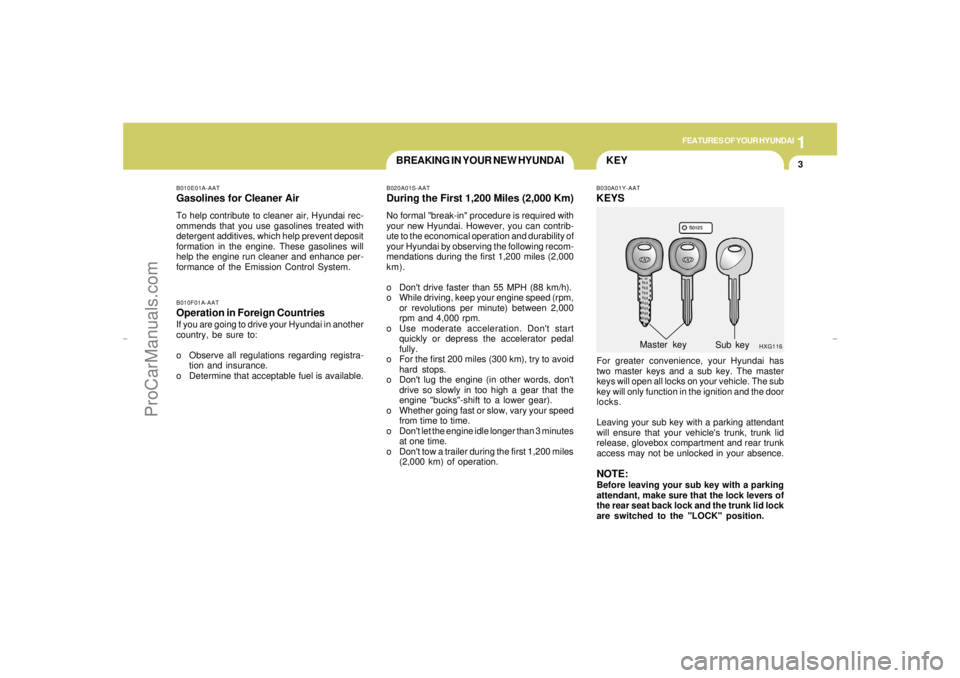
1
FEATURES OF YOUR HYUNDAI
3
KEY
BREAKING IN YOUR NEW HYUNDAI
B010E01A-AATGasolines for Cleaner AirTo help contribute to cleaner air, Hyundai rec-
ommends that you use gasolines treated with
detergent additives, which help prevent deposit
formation in the engine. These gasolines will
help the engine run cleaner and enhance per-
formance of the Emission Control System.B010F01A-AATOperation in Foreign CountriesIf you are going to drive your Hyundai in another
country, be sure to:
o Observe all regulations regarding registra-
tion and insurance.
o Determine that acceptable fuel is available.
B020A01S-AATDuring the First 1,200 Miles (2,000 Km)No formal "break-in" procedure is required with
your new Hyundai. However, you can contrib-
ute to the economical operation and durability of
your Hyundai by observing the following recom-
mendations during the first 1,200 miles (2,000
km).
o Don't drive faster than 55 MPH (88 km/h).
o While driving, keep your engine speed (rpm,
or revolutions per minute) between 2,000
rpm and 4,000 rpm.
o Use moderate acceleration. Don't start
quickly or depress the accelerator pedal
fully.
o For the first 200 miles (300 km), try to avoid
hard stops.
o Don't lug the engine (in other words, don't
drive so slowly in too high a gear that the
engine "bucks"-shift to a lower gear).
o Whether going fast or slow, vary your speed
from time to time.
o Don't let the engine idle longer than 3 minutes
at one time.
o Don't tow a trailer during the first 1,200 miles
(2,000 km) of operation.
B030A01Y-AATKEYSFor greater convenience, your Hyundai has
two master keys and a sub key. The master
keys will open all locks on your vehicle. The sub
key will only function in the ignition and the door
locks.
Leaving your sub key with a parking attendant
will ensure that your vehicle's trunk, trunk lid
release, glovebox compartment and rear trunk
access may not be unlocked in your absence.NOTE:Before leaving your sub key with a parking
attendant, make sure that the lock levers of
the rear seat back lock and the trunk lid lock
are switched to the "LOCK" position.
HXG116
Master key
Sub key
xgflhma-1.p656/16/04, 3:02 PM 3
ProCarManuals.com
Page 35 of 247
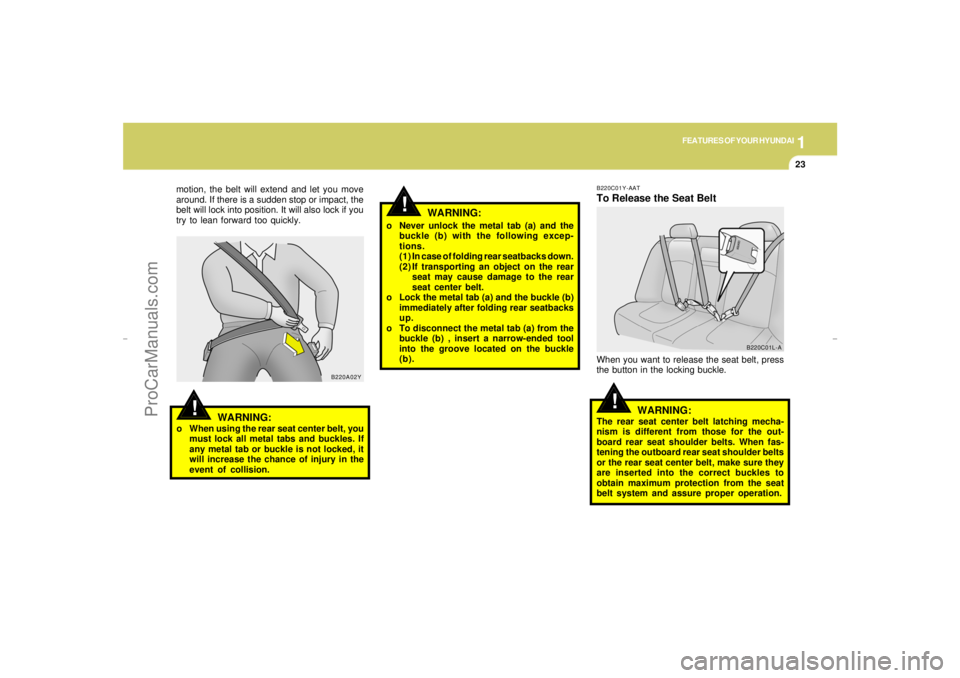
1
FEATURES OF YOUR HYUNDAI
23
!
!
!
B220C01Y-AATTo Release the Seat BeltWhen you want to release the seat belt, press
the button in the locking buckle.
WARNING:
The rear seat center belt latching mecha-
nism is different from those for the out-
board rear seat shoulder belts. When fas-
tening the outboard rear seat shoulder belts
or the rear seat center belt, make sure they
are inserted into the correct buckles to
obtain maximum protection from the seat
belt system and assure proper operation.
B220C01L-A
WARNING:
o When using the rear seat center belt, you
must lock all metal tabs and buckles. If
any metal tab or buckle is not locked, it
will increase the chance of injury in the
event of collision.
B220A02Y
motion, the belt will extend and let you move
around. If there is a sudden stop or impact, the
belt will lock into position. It will also lock if you
try to lean forward too quickly.
o Never unlock the metal tab (a) and the
buckle (b) with the following excep-
tions.
(1) In case of folding rear seatbacks down.
(2) If transporting an object on the rear
seat may cause damage to the rear
seat center belt.
o Lock the metal tab (a) and the buckle (b)
immediately after folding rear seatbacks
up.
o To disconnect the metal tab (a) from the
buckle (b) , insert a narrow-ended tool
into the groove located on the buckle
(b).
WARNING:
xgflhma-1.p656/16/04, 3:02 PM 23
ProCarManuals.com
Page 56 of 247
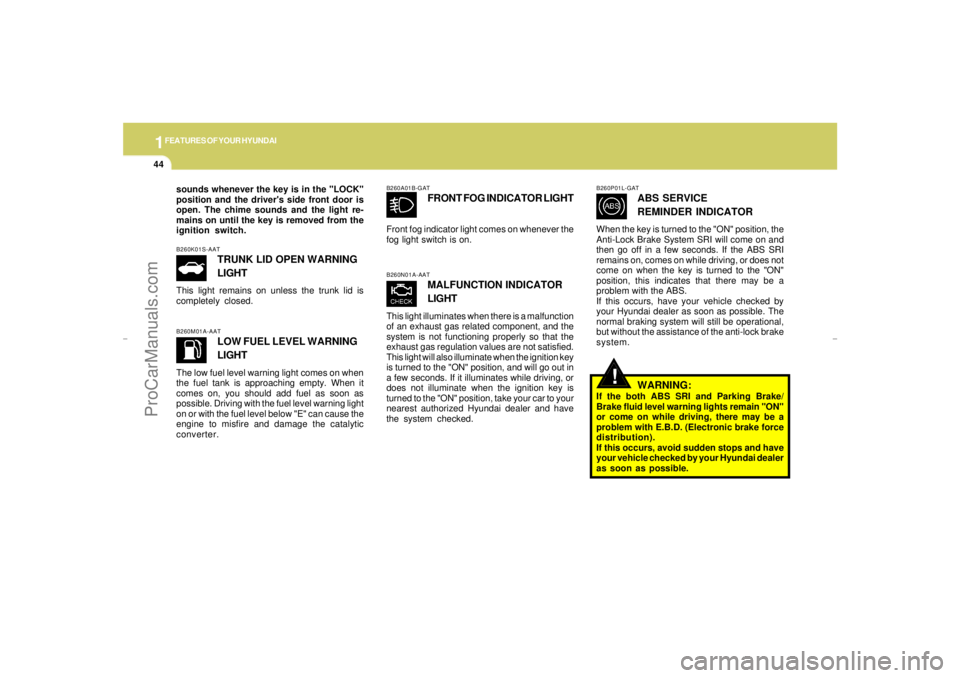
1FEATURES OF YOUR HYUNDAI44
!
B260M01A-AAT
LOW FUEL LEVEL WARNING
LIGHT
The low fuel level warning light comes on when
the fuel tank is approaching empty. When it
comes on, you should add fuel as soon as
possible. Driving with the fuel level warning light
on or with the fuel level below "E" can cause the
engine to misfire and damage the catalytic
converter.
B260N01A-AAT
MALFUNCTION INDICATOR
LIGHT
This light illuminates when there is a malfunction
of an exhaust gas related component, and the
system is not functioning properly so that the
exhaust gas regulation values are not satisfied.
This light will also illuminate when the ignition key
is turned to the "ON" position, and will go out in
a few seconds. If it illuminates while driving, or
does not illuminate when the ignition key is
turned to the "ON" position, take your car to your
nearest authorized Hyundai dealer and have
the system checked.
B260P01L-GAT
ABS SERVICE
REMINDER INDICATOR
When the key is turned to the "ON" position, the
Anti-Lock Brake System SRI will come on and
then go off in a few seconds. If the ABS SRI
remains on, comes on while driving, or does not
come on when the key is turned to the "ON"
position, this indicates that there may be a
problem with the ABS.
If this occurs, have your vehicle checked by
your Hyundai dealer as soon as possible. The
normal braking system will still be operational,
but without the assistance of the anti-lock brake
system.
WARNING:
If the both ABS SRI and Parking Brake/
Brake fluid level warning lights remain "ON"
or come on while driving, there may be a
problem with E.B.D. (Electronic brake force
distribution).
If this occurs, avoid sudden stops and have
your vehicle checked by your Hyundai dealer
as soon as possible.
B260A01B-GAT
FRONT FOG INDICATOR LIGHT
Front fog indicator light comes on whenever the
fog light switch is on.
B260K01S-AAT
TRUNK LID OPEN WARNING
LIGHT
This light remains on unless the trunk lid is
completely closed. sounds whenever the key is in the "LOCK"
position and the driver's side front door is
open. The chime sounds and the light re-
mains on until the key is removed from the
ignition switch.
xgflhma-1.p656/16/04, 3:03 PM 44
ProCarManuals.com
Page 131 of 247

Before Starting the Engine ............................................ 2-3
Key Positions ................................................................ 2-3
Starting ..........................................................................2-4
Automatic Transaxle ..................................................... 2-5
Anti-Lock Brake System (ABS) .................................... 2-8
Traction Control System (TCS) .................................... 2-9
Good Braking Practices..............................................2-10
Driving for Economy...................................................2-11
Winter Driving.............................................................2-13
Trailer or Vehicle Towing ............................................2-15
Vehicle Load Limit.......................................................2-19
DRIVING YOUR HYUNDAI
2
2
xgflhma-2.p656/16/04, 3:00 PM 1
ProCarManuals.com
Page 138 of 247

2
DRIVING YOUR HYUNDAI8
ANTI-LOCK BRAKE SYSTEM
GOOD DRIVING PRACTICES
!
C120A02A-AAT(If Installed)The Anti-Lock Brake System (ABS) is designed
to prevent wheel lock-up during sudden braking
or on hazardous road surfaces. The ABS con-
trol module monitors the wheel speed and con-
trols the pressure applied to each brake. Thus,
in emergency situations or on slick roads, ABS
will increase vehicle control during braking.NOTE:During ABS operation, a pulsation may be
felt in the brake pedal when the brakes are
applied. Also, a noise may be heard in the
engine compartment while braking. These
conditions are normal and indicate that the
anti-lock brake system is functioning prop-
erly.
C090N03Y-AATo Never move the gear selector lever from "P"
or "N" to any other position with the accelera-
tor pedal depressed.
o Never move the gear selector lever into "P"
when the vehicle is in motion.
o Be sure the car is completely stopped before
you attempt to shift into "R".
o Never take the car out of gear and coast
down a hill. This may be extremely hazard-
ous. Always leave the car in gear when
moving.
o Do not "ride" the brakes. This can cause
them to overheat and malfunction. Instead,
when you are driving down a long hill, slow
down and shift to a lower gear. When you do
this, engine braking will help slow the car.
o Slow down before shifting to a lower gear.
Otherwise, the lower gear may not be en-
gaged.
o Always use the parking brake. Do not de-
pend on placing the transaxle in "P" to keep
the car from moving.
o Exercise extreme caution when driving on a
slippery surface. Be especially careful when
braking, accelerating or shifting gears. On a
slippery surface, an abrupt change in ve-
hicle speed can cause the drive wheels to
lose traction and the vehicle to go out of
control.
WARNING:
o The risk of rollover is greatly increased if
you lose control of your vehicle at high-
way speeds.
o Loss of control often occurs if two or
more wheels drop off the roadway and
the driver oversteers to reenter the road-
way.
o In the event your vehicle leaves the road-
way, do not steer sharply. Instead, slow
down before pulling back into the travel
lanes.
o In a collision crash, an unbelted person
is significantly more likely to die than a
person wearing a seatbelt.
o Never exceed posted speed limits.
o Excessive depressing of the accelerater
pedal in slippery driving conditions such
as pulling out of deep snow or mud may
cause severe damage to the transaxle.
Rocking the vehicle is not recommended.
Rather, use an appropriate towing
method.
xgflhma-2.p656/16/04, 3:00 PM 8
ProCarManuals.com
Page 139 of 247

DRIVING YOUR HYUNDAI
92
TRACTION CONTROL SYSTEM
(TCS)
!
!
WARNING:
Your ABS will not prevent accidents due to
improper or dangerous driving maneuvers.
Even though vehicle control is improved
during emergency braking, always main-
tain a safe distance between you and ob-
jects ahead. Vehicle speeds should always
be reduced during extreme road condi-
tions.
The braking distance for cars equipped
with an anti-lock braking system may be
longer than for those without it in the
following road conditions.
During these conditions the vehicle should
be driven at reduced speeds.
o Rough, gravel or snow-covered roads.
o With tire chains installed.
o On roads where the road surface is pit-
ted or has different surface height.
The safety features of an ABS equipped
vehicle should not be tested by high speed
driving or cornering. This could endanger
the safety of yourself or others.
C300A02Y-GAT(If Installed)
!
On slippery road surfaces, the traction control
system (TCS) limits the drive wheels from
spinning excessively, thus helping the car to
accelerate. It also provides sufficient driving
force and steering performance as the car turns
at accelerated speeds.SLIP ControlLimits the drive wheels from spinning exces-
sively during starting or while making acceler-
ated turns on slippery roads to avoid losing the
driving force of the front wheels.
CAUTION:
When the TCS indicator blinks, SLIP control
has been activated. It also means that the
road is slippery or your car is accelerating
excessively. In this situation, gently release
foot pressure from the accelerator pedal
and maintain moderate speed.
WARNING:
Traction control is only a driving aid; all
normal precautions for driving in inclement
weather and on slippery driving surfaces
should be observed.
C300A02L-A
Driving hintsTCS does not actively apply brakes. Be sure to
decelerate the car sufficiently before entering
curves.
xgflhma-2.p656/16/04, 3:00 PM 9
ProCarManuals.com
Page 169 of 247
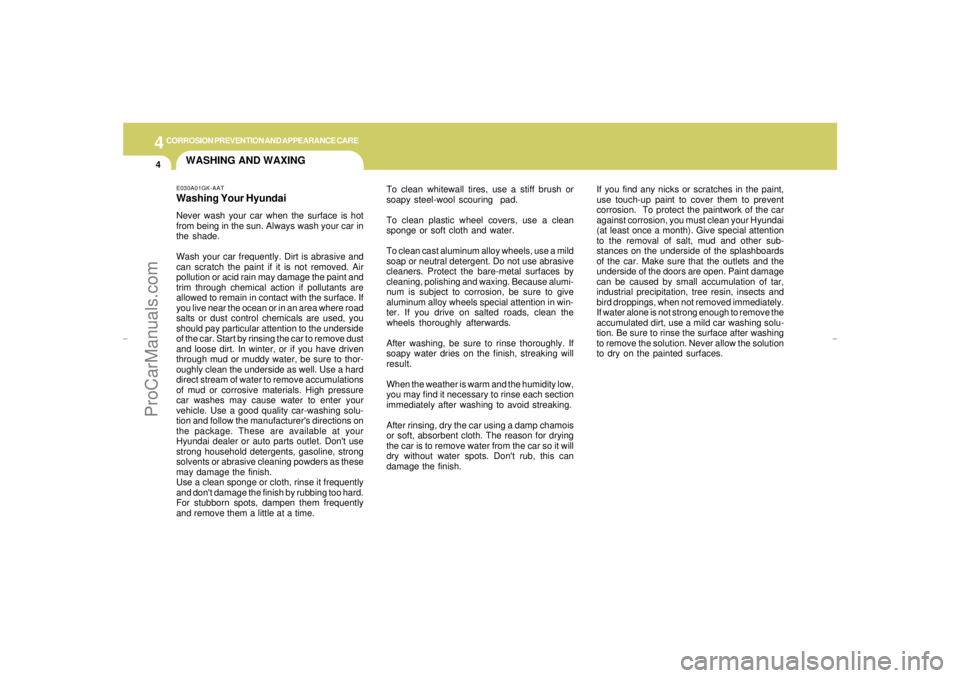
44
CORROSION PREVENTION AND APPEARANCE CARE4
WASHING AND WAXING
If you find any nicks or scratches in the paint,
use touch-up paint to cover them to prevent
corrosion. To protect the paintwork of the car
against corrosion, you must clean your Hyundai
(at least once a month). Give special attention
to the removal of salt, mud and other sub-
stances on the underside of the splashboards
of the car. Make sure that the outlets and the
underside of the doors are open. Paint damage
can be caused by small accumulation of tar,
industrial precipitation, tree resin, insects and
bird droppings, when not removed immediately.
If water alone is not strong enough to remove the
accumulated dirt, use a mild car washing solu-
tion. Be sure to rinse the surface after washing
to remove the solution. Never allow the solution
to dry on the painted surfaces.
E030A01GK-AATWashing Your HyundaiNever wash your car when the surface is hot
from being in the sun. Always wash your car in
the shade.
Wash your car frequently. Dirt is abrasive and
can scratch the paint if it is not removed. Air
pollution or acid rain may damage the paint and
trim through chemical action if pollutants are
allowed to remain in contact with the surface. If
you live near the ocean or in an area where road
salts or dust control chemicals are used, you
should pay particular attention to the underside
of the car. Start by rinsing the car to remove dust
and loose dirt. In winter, or if you have driven
through mud or muddy water, be sure to thor-
oughly clean the underside as well. Use a hard
direct stream of water to remove accumulations
of mud or corrosive materials. High pressure
car washes may cause water to enter your
vehicle. Use a good quality car-washing solu-
tion and follow the manufacturer's directions on
the package. These are available at your
Hyundai dealer or auto parts outlet. Don't use
strong household detergents, gasoline, strong
solvents or abrasive cleaning powders as these
may damage the finish.
Use a clean sponge or cloth, rinse it frequently
and don't damage the finish by rubbing too hard.
For stubborn spots, dampen them frequently
and remove them a little at a time.To clean whitewall tires, use a stiff brush or
soapy steel-wool scouring pad.
To clean plastic wheel covers, use a clean
sponge or soft cloth and water.
To clean cast aluminum alloy wheels, use a mild
soap or neutral detergent. Do not use abrasive
cleaners. Protect the bare-metal surfaces by
cleaning, polishing and waxing. Because alumi-
num is subject to corrosion, be sure to give
aluminum alloy wheels special attention in win-
ter. If you drive on salted roads, clean the
wheels thoroughly afterwards.
After washing, be sure to rinse thoroughly. If
soapy water dries on the finish, streaking will
result.
When the weather is warm and the humidity low,
you may find it necessary to rinse each section
immediately after washing to avoid streaking.
After rinsing, dry the car using a damp chamois
or soft, absorbent cloth. The reason for drying
the car is to remove water from the car so it will
dry without water spots. Don't rub, this can
damage the finish.
xgflhma-4.p656/16/04, 2:59 PM 4
ProCarManuals.com
Page 213 of 247
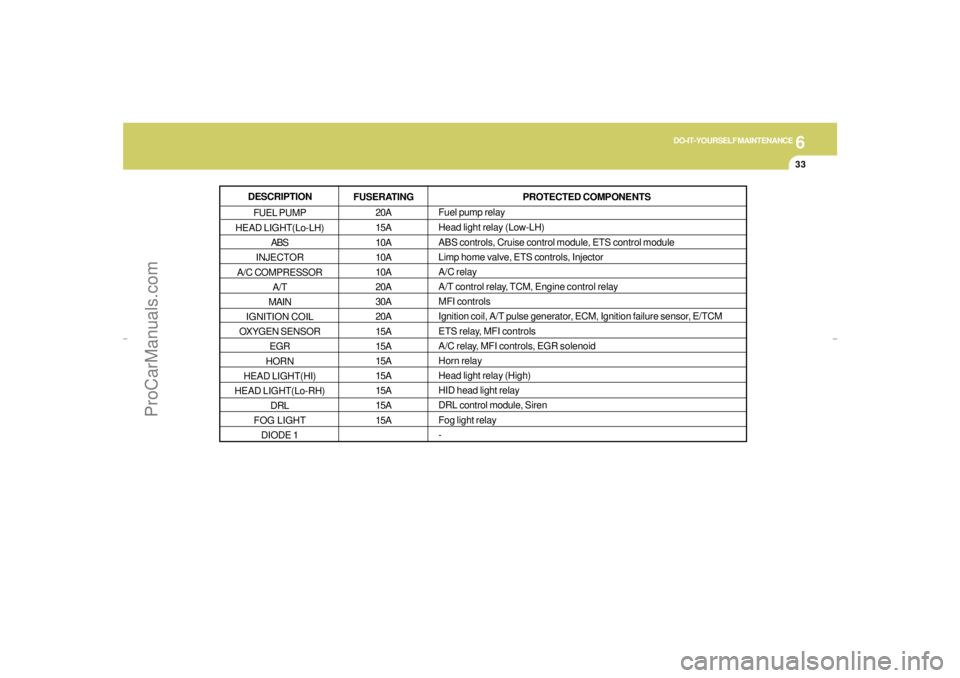
6
DO-IT-YOURSELF MAINTENANCE
33
DESCRIPTION
FUEL PUMP
HEAD LIGHT(Lo-LH)
ABS
INJECTOR
A/C COMPRESSOR
A/T
MAIN
IGNITION COIL
OXYGEN SENSOR
EGR
HORN
HEAD LIGHT(HI)
HEAD LIGHT(Lo-RH)
DRL
FOG LIGHT
DIODE 1FUSERATING
20A
15A
10A
10A
10A
20A
30A
20A
15A
15A
15A
15A
15A
15A
15AFuel pump relay
Head light relay (Low-LH)
ABS controls, Cruise control module, ETS control module
Limp home valve, ETS controls, Injector
A/C relay
A/T control relay, TCM, Engine control relay
MFI controls
Ignition coil, A/T pulse generator, ECM, Ignition failure sensor, E/TCM
ETS relay, MFI controls
A/C relay, MFI controls, EGR solenoid
Horn relay
Head light relay (High)
HID head light relay
DRL control module, Siren
Fog light relay
-
PROTECTED COMPONENTS
xgflhma-6.p656/16/04, 2:59 PM 33
ProCarManuals.com
Page 214 of 247
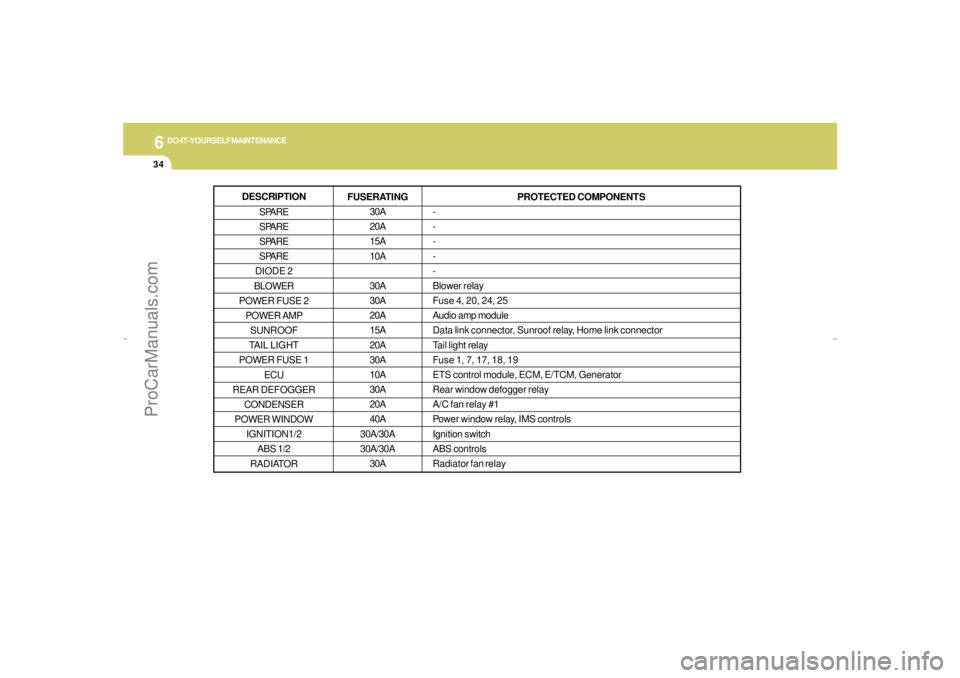
6
DO-IT-YOURSELF MAINTENANCE
34
DESCRIPTION
SPARE
SPARE
SPARE
SPARE
DIODE 2
BLOWER
POWER FUSE 2
POWER AMP
SUNROOF
TAIL LIGHT
POWER FUSE 1
ECU
REAR DEFOGGER
CONDENSER
POWER WINDOW
IGNITION1/2
ABS 1/2
RADIATORFUSERATING
30A
20A
15A
10A
30A
30A
20A
15A
20A
30A
10A
30A
20A
40A
30A/30A
30A/30A
30A-
-
-
-
-
Blower relay
Fuse 4, 20, 24, 25
Audio amp module
Data link connector, Sunroof relay, Home link connector
Tail light relay
Fuse 1, 7, 17, 18, 19
ETS control module, ECM, E/TCM, Generator
Rear window defogger relay
A/C fan relay #1
Power window relay, IMS controls
Ignition switch
ABS controls
Radiator fan relay
PROTECTED COMPONENTS
xgflhma-6.p656/16/04, 2:59 PM 34
ProCarManuals.com